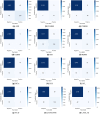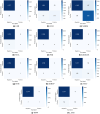Deep residual 2D convolutional neural network for cardiovascular disease classification
- PMID: 39327440
- PMCID: PMC11427665
- DOI: 10.1038/s41598-024-72382-3
Deep residual 2D convolutional neural network for cardiovascular disease classification
Abstract
Cardiovascular disease (CVD) continues to be a major global health concern, underscoring the need for advancements in medical care. The use of electrocardiograms (ECGs) is crucial for diagnosing cardiac conditions. However, the reliance on professional expertise for manual ECG interpretation poses challenges for expanding accessible healthcare, particularly in community hospitals. To address this, there is a growing interest in leveraging automated and AI-driven ECG analysis systems, which can enhance diagnostic accuracy and efficiency, making quality cardiac care more accessible to a broader population. In this study, we implemented a novel deep two-dimensional convolutional neural network (2D-CNN) on a dataset of PTB-XL for cardiac disorder detection. The studies were performed on 2, 5, and 23 classes of cardiovascular diseases. The our network in classifying healthy/sick patients achived an AUC of 95% and an average accuracy of 87.85%. In 5-classes classification, our model achieved an AUC of 93.46% with an average accuracy of 89.87%. In a more complex scenario involving classification into 23 different classes, the model achieved an AUC of 92.18% and an accuracy of 96.88%. According to the experimental results, our model obtained the best classification result compared to the other methods based on the same public dataset. This indicates that our method can aid healthcare professionals in the clinical analysis of ECGs, offering valuable assistance in diagnosing CVD and contributing to the advancement of computer-aided diagnosis technology.
© 2024. The Author(s).
Conflict of interest statement
The authors declare no competing interests.
Figures










Similar articles
-
Enhancing cardiovascular disease classification in ECG spectrograms by using multi-branch CNN.Comput Biol Med. 2025 Mar;186:109737. doi: 10.1016/j.compbiomed.2025.109737. Epub 2025 Jan 25. Comput Biol Med. 2025. PMID: 39864336
-
Detection and classification of electrocardiography using hybrid deep learning models.Hellenic J Cardiol. 2025 Jan-Feb;81:75-84. doi: 10.1016/j.hjc.2024.08.011. Epub 2024 Aug 30. Hellenic J Cardiol. 2025. PMID: 39218394
-
An automated ECG-based deep learning for the early-stage identification and classification of cardiovascular disease.Technol Health Care. 2024;32(6):5025-5045. doi: 10.3233/THC-240543. Technol Health Care. 2024. PMID: 39302394
-
Artificial intelligence-enhanced electrocardiography for accurate diagnosis and management of cardiovascular diseases.J Electrocardiol. 2024 Mar-Apr;83:30-40. doi: 10.1016/j.jelectrocard.2024.01.006. Epub 2024 Jan 28. J Electrocardiol. 2024. PMID: 38301492 Review.
-
DeepFHR: intelligent prediction of fetal Acidemia using fetal heart rate signals based on convolutional neural network.BMC Med Inform Decis Mak. 2019 Dec 30;19(1):286. doi: 10.1186/s12911-019-1007-5. BMC Med Inform Decis Mak. 2019. PMID: 31888592 Free PMC article. Review.
Cited by
-
Fully Automated Diagnosis of Acute Myocardial Infarction Using Electrocardiograms and Multimodal Deep Learning.JACC Adv. 2025 Aug;4(8):102011. doi: 10.1016/j.jacadv.2025.102011. Epub 2025 Jul 17. JACC Adv. 2025. PMID: 40675022 Free PMC article.
References
-
- World health organization. cardiovascular disease (cvds). https://www.who.int/news-room/fact-sheets/detail/cardiovascular-diseases...www.who.int/news-room/fact-sheets/detail/cardiovascular-diseases-(cvds) (2023 (accessed September 11, 2023)).
-
- Tripathy, R. & Dandapat, S. Detection of cardiac abnormalities from multilead ecg using multiscale phase alternation features. J. Med. Syst.40, 1–9 (2016). - PubMed
-
- Asgari, S., Mehrnia, A. & Moussavi, M. Automatic detection of atrial fibrillation using stationary wavelet transform and support vector machine. Comput. Biol. Med.60, 132–142 (2015). - PubMed
-
- Li, T. & Zhou, M. Ecg classification using wavelet packet entropy and random forests. Entropy18, 285 (2016).
MeSH terms
LinkOut - more resources
Full Text Sources

